I’ve been without internet for quite awhile. Since writing last I’ve gone interior where I’ll be another couple weeks. Our internet unexpectedly started working again (intermittently) so I get to update ye olde blog.
I’m staying with a missionary family out in the bush among the Moi tribe, helping them get set back up here after a year of absence.
Though I now have internet (via satellite dish), we truly are in one of the last remaining boondocks of the globe, I think. It’s a strange mix of modern influence and stone-age lifestyle. In many ways being here is like a time warp.
Our flight was May 14th. We came in on a six-seater Kodiak plane early in the morning. We had two flights chartered: one for us and one for the luggage.
The reason we flew in early became apparent to me after living here awhile: we get clouds and rain pretty much every afternoon that would make landing tough. (there is tons of rain here, they don’t call it a rainforest for nothing, I guess.)
Even though the morning we came in was a clear, calm one, the landing still seemed intense. After clearing the nearby mountains the pilot descended by circling several times to lose enough altitude for landing, then we shot in fast over the houses and landed on this short, sloped runway. The end of the runway even has a hill, which is a new one.
The runway took seven years to build. It is basically a smooth swathe of jungle notched right out of the side of a mountain. The terrain here is ruggedly incredible.
There have been outsiders here since the late 90s (when the tribe was “discovered”), and for the first number of years while the runway was still being worked on the only access was via helicopter, which is significantly more expensive.
Here are pictures from the journey:
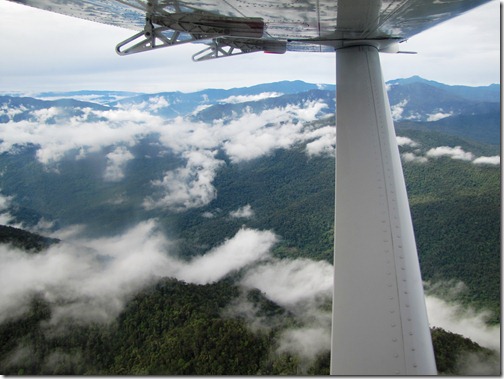
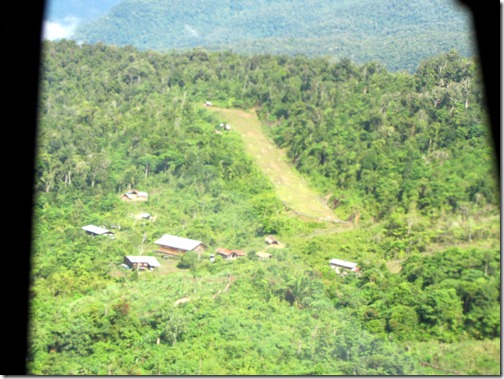
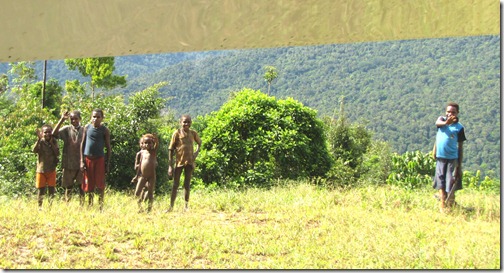
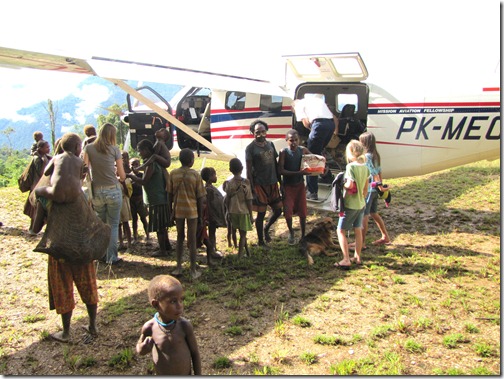
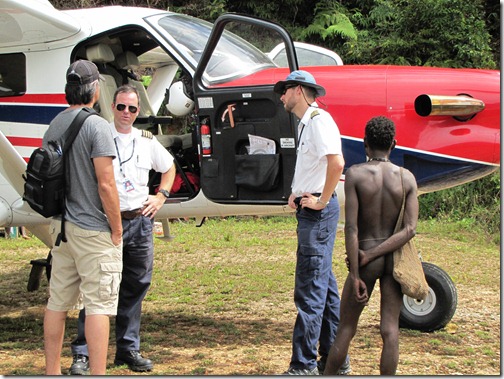
One of the MAF pilots was getting qualified for landing on this airstrip, so after we were safely dropped off the pilots did a number of practice landings.
Here are a few pictures and a video I took of the landings and takeoffs (the video is low quality because our internet is quite slow for uploading):

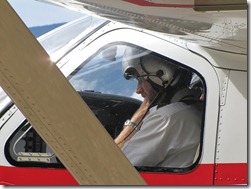
But before long, the planes left, leaving us physically cutoff from the outside world!
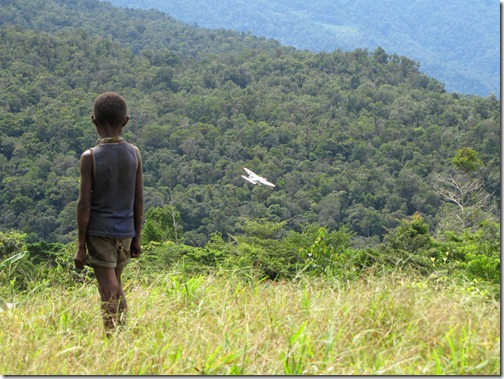
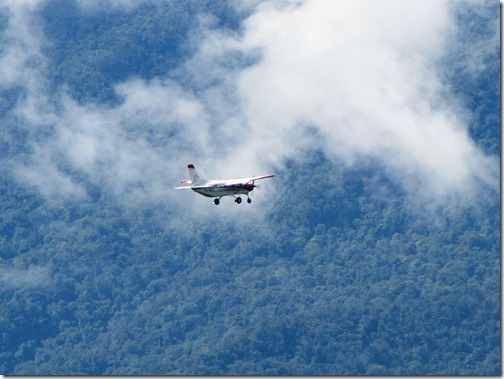
Below is a picture of some of our welcoming committee. Though some men wear western clothes (shorts and tee-shirt), the majority don’t. The men below are in native attire.
Seems to me the tribal clothing style for men does the exact opposite of what clothes are supposed to do: rather than discreetly covering, they draw special attention. Their gourds are an enhancement.
So most the last week was spent getting settled in, fixing things, and cleaning, as the house had been sitting vacant for a year. It was like going to Mound City: the yard needed mowed, the lawn mower fixed, bugs swept off the porch, etc. Pigs had rutted around in their yard and pretty much destroyed that as well. The whole place was overgrown and everything quite dirty.
It was much worse than Mound City. For one thing, their house is more like a “cabin” than a nicely insulated home. It’s made from rough-hewn boards cut from local timber (via chainsaw). No insulation, no glass windows, no concrete foundation, simple tin roof, etc. The picture of their house (below) makes it look more modern than it is! (I can see light through cracks between boards in my wall as I type this)
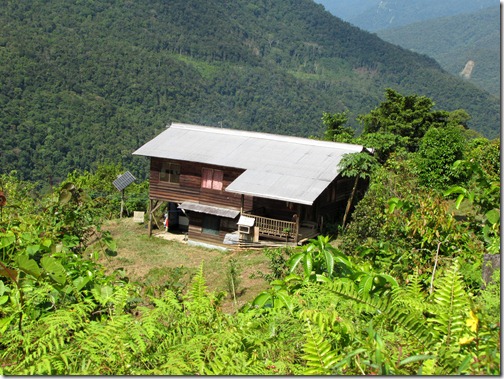
First thing needed fixing was water. A PVC pipe fed water to their house from a spring up the hill. The inlet wasn’t sucking water anymore (wasn’t even in the water for some reason) and needed adjustment, then primed, which required hauling a car battery and backup portable pump up the hill through the jungle to the spring source. After a considerable amount of slip-sliding in mud, swatting half the known bugs in the universe, and sweating out 84% of my water content (among a few other sordid adventures) water in the house was finally running again! This was good, because I was thirsty.

After Rich and I spent the better part of several days troubleshooting the internet, we gave up on that. Turns out it wasn’t anything wrong on our end because it just started working one day after fixing itself. Well, it sorta works, it randomly switches on and off.
Fortunately, we also have a satellite phone which can be used to contact the outside world, but it is expensive to use. We also have a radio and make contact each day with that.
Check out the antennae on our sat phone!
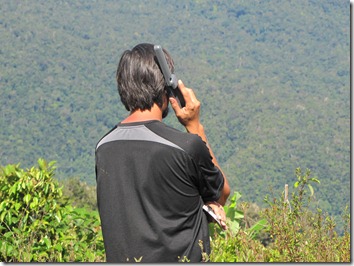
There has been some termite damage. Ok, a lot of termite damage. The little boogers got into books and all sorts of other jazz.
There are also rats (and spiders and biting centipedes and geckos and sticky flies). So far we’ve caught no fewer than seven rats, all within about twelve feet of my bed! One we caught underneath my bed. There are still more though, just yesterday I was sitting reading a book and stuff kept falling on my head from the rafters above.
Some of the rats we’ve drowned, others gave to locals for food. They eat that sort of thing, as well as frogs (saw a guy with one the other day), fruit bats, and spiders. Apparently their diet lacks protein. They have pigs, but not many, and just eat them on special occasions.
Here’s a picture of my room (after being cleaned up):
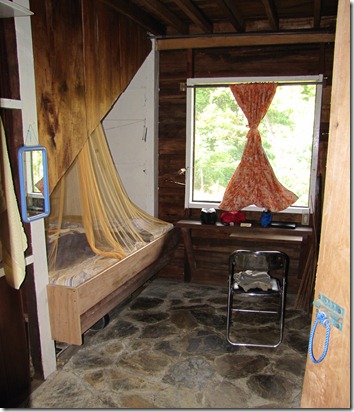
There is a “frontier feeling” in this place. Once the plane flew out we were left on our own with the locals – no way out until a plane comes to get us again. There are no roads in. All our power is via solar panels. Our water is via mountain spring. Foodwise we brought in lots of staples – complemented by local fruits and vegetables (such as taro, avocado, and papayas), but everything has to be cooked from scratch, which Karen does an amazing job doing, I might add.
Yet the family has lived here eight years so this is old hat to them.
For a few days I got sick with a cold and did a lot of reading. One book I read was Guns, Germs, and Steel and found it quite enlightening. The basic premise the author attempts to prove is the differences in the rise of technology on different continents being due more to geographic and environmental variables than inherit differences between the people groups themselves. In other words, people living primitively are not doing so because they’re less smart, but because their native environment won’t support a higher civilization. The book paid particular attention to the natural animals and food crops each continent had.
For instance, North and South America combined only had one large mammal that was domesticable (the Llama of Peru), whereas Eurasia had 13 such large animals (like the cow for milk, leather, and meat – the ox for pulling plows – the horse for transportation). This inherit difference alone was a major obstacle to the Native American Indians developing the same type of sophistication possible in Eurasia.
In a similar vein, looking at agriculture we find the Mediterranean zone had 32 of the top 56 large-seeded grass species (like barley, wheat, beans, etc) whereas Sub-Saharan Africa only had 2! This means farming was less viable an option there. The advantages of farming are multiplous, including the opportunity for food surplus’s to develop, the ability for a greater population to live per acre, and the rise of specialized tradesmen who don’t have to spend all day gathering food for themselves.
What I learned in the book hit closer to home as I see here there is no possible way here to do the type of farming we do back in Kansas. I’ve never seen more rugged terrain in my life! The Moi are highlanders; everywhere I look are sharp mountain ridges. Any flat real estate is a rare commodity. Even the house I’m sitting in is built on a hill.
Everywhere I walk seems to be either up or down, and the walking is treacherous as the mud makes everything ice-like slippy. I’ve had my feet slide out from under me when I was just standing in one place minding my own business! Now that’s disconcerting.
Here’s a quote from the book I found interesting:
“New Guinea’s population is not only small in aggregate, but also fragmented into thousands of micro populations by the rugged terrain: swamps in much of the lowlands, steep-sided ridges and narrow canyons alternating with each other in the highlands, and dense jungle swathing both the lowlands and the highlands.
When I am engaged in biological exploration in New Guinea, with teams of New Guineans as field assistants, I consider excellent progress to be three miles per day even if we are traveling over existing trails. Most highlanders in traditional New Guinea never went more than 10 miles from home in the course of their lives.” (pg 306)
Can you imagine living your entire life and never travelling more than ten miles from where you were born? All quite fascinating.
This morning I went out bird hunting with a couple of the younger guys. We tramped around through the jungle for four hours. I’d say half the time we were on what I’d term a “deer trail” (though there are no deer here), and the other half was purely “bushwacking” it through the jungle.
We hunted with pellet guns; I was a little disappointed we didn’t use bows and arrows as every guy here has there own set and carries it around with them religiously wherever they go.
Here’s a picture I took one evening last week of several guys when we were out walking on the airstrip. They were playing a game of seeing who could shoot their arrows the furthest. I marked off the distance they could shoot and it was about 100 paces (~100 yds). The bows are a lot like the ones Joe makes. They use a wood from a certain Palm Tree for the bow. I watched a guy today shaving away on one using a piece of bamboo shoot for a razor.
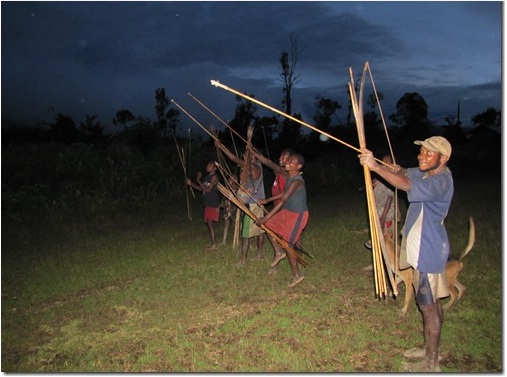
But they’re moving into the modern age now, bows and arrows are fine for carrying around the village, but when you’re ready to kill the birds it’s best to pull out the pellet gun (though I’m told they can shoot birds with arrows too).
While we were out hunting, I heard a lot of birds, and Sapiya actually shot one (of unknown type, but something like a quail). To be honest though, I never even spotted a bird in the thick jungle canopy.
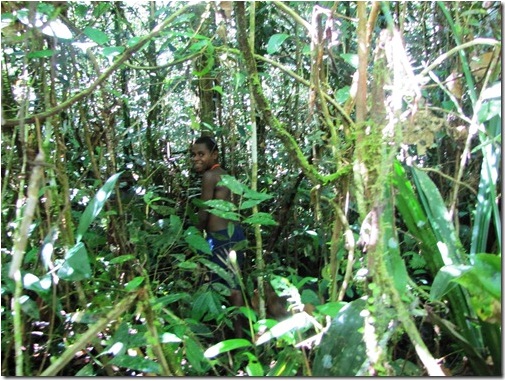
The “hiking through the jungle” part was kinda like slogging around the jungle section of the Sedgwick County Zoo, but off the path. Also reminded me of some places Luke and I hiked around in in Oregon, except more dense with steeper terrain.
I used the word, “slogging.” That’s what I was doing. But the two guys I was with (the younger one above and Sapiya who is a little older) waltzed along as if we were on a Sunday stroll. In the four hours we were out they never once slipped, got winded, took a drink of water, or even seemed to sweat much. They both were barefoot – thorns, vines and all. In contrast, most the time I was out of breath, falling down, slipping, sliding, drinking liter after liter of water, and sweating so profusely I turned into a giant sweat blob. I reminded myself of Po in Kung Fu Panda.
And you know how in the rainforest section of the Sedgwick County Zoo your glasses always fog up? That’s how it was for my glasses too most the morning: the steamy fog combined with the sweat of my brow turned my lenses into such a soppy mess I couldn’t see nuthin’ (like birds).
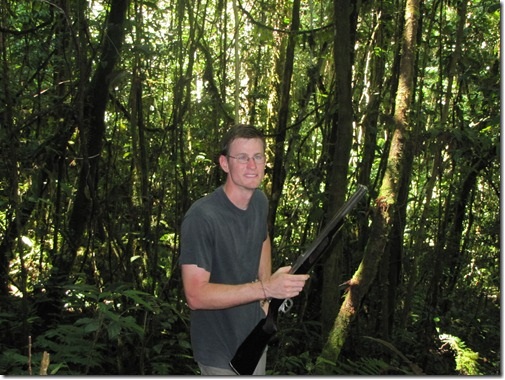
Enough about hunting birds, another book I’ve recently read is, Lords of the Earth by Don Richardson. Don’t think if I’ve ever read so violent a book before, people are getting killed and murdered from the first page to the last page – a real page turner, to be sure.
Lords of the Earth tells the story of ex-commando Australian turned missionary (Stanley Albert Dale) and his work among the Yali cannibal tribe in former Irian Jaya (now Papua).
In reference to the title, “Lords of the Earth,” Don had this to say:
In their primal isolation, the Yali considered themselves “lords of the earth.” Now they are discovering that in the eyes of patrol officers, schoolteachers, tourists and traders, they are not “lords of the earth” at all, but only “backward primitive,” whose simplicity leaves them open to easy exploitation and abuse.
A similar issue faces the Moi, who are only now being exposed to outside influence. It’s quite intriguing to me as they are obviously quite more advanced than myself in regards to living in the wild. I’m told they know every plant and tree, what’s edible and what’s poisonous, and walking through the woods to them is like walking through a supermarket to us.
Trying to keep up with them on their trails is pretty much a lost cause; I look like a clown. But they don’t know much about computers or the modern age. They had no written language until the missionaries gave them one, and though some can now read and write, there aren’t many books translated into Moi. Not even the entire Bible.
It stretches my mind to think of what it would have been like to have been born into a culture like this. To be a grown-up and not know how to do basic arithmetic or be familiar with world history or able to read??
Oh well, too much to think about. At least their life is simpler and less complicated, which is a plus.
In other news, I’ve gotten in some pretty serious games of UNO with the three girls here (8, 10, and 12 years old). I taught them additional rules which makes the game faster paced and more funner. Unfortunately, it’s got to where they always beat me, they’re so fast I can’t compete! But we have fun.
Ok, that’s the rambly brambly update from this end.
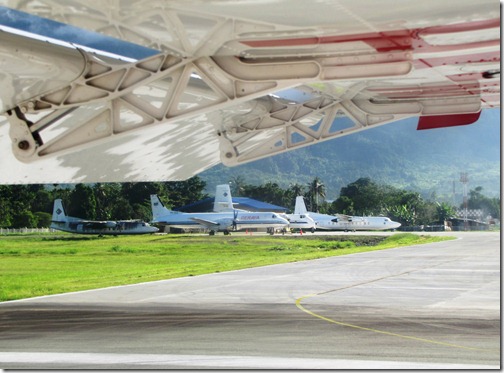

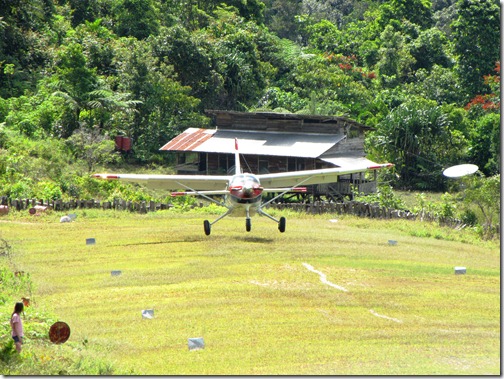
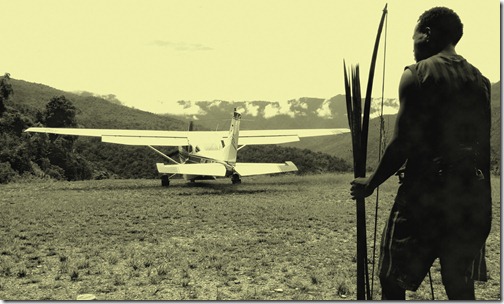
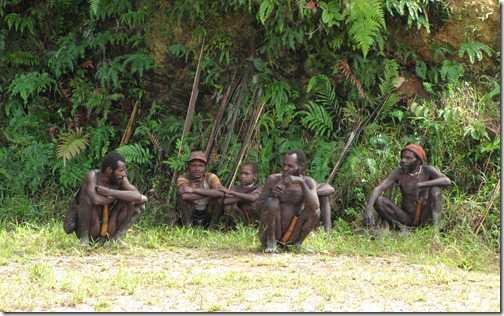
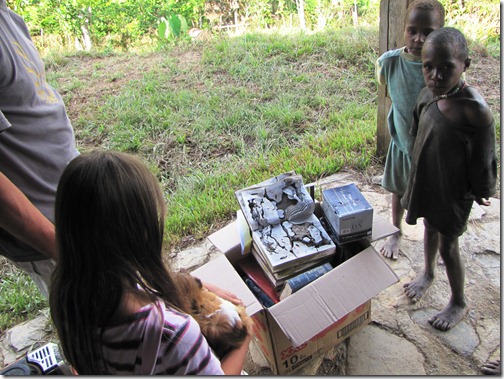
As part of my daily booting-up-the-computer routine, I check your blog. Though, knowing you’re in such a remote location, I haven’t really expected to see anything new ’till you return to “civilization”.
What a fun surprise this morning!!
Thanks for the update!! 🙂
Good to hear from you NICK! Enjoyed the pictures and stories. We have lots to talk about when you get home… up for another all-nighter? Miss you and pray for you when I think about you!
Guns, Germs and Steel makes the argument that it is geography rather than biology that determines the destiny of civilisations. This seems to be a secular version of Acts 17:26: “From one man he made every nation of men, that they should inhabit the whole earth; and he determined the times set for them and the exact places where they should live.”
Yea, another blog post to read! So I’m guessing you are NOT heading back to counsel at any camps in June? Tonight I received the speaker list for June and you have been tentatively scheduled for Wednesday, June 27. LOL I think I’ll put “TBA” since I don’t even know when you’ll see this message. 😉 But just in case, you can let me (who can let Duane) know….. 😉
Hi Nick,
I don’t know if you’ll receive this, but I’m a grandma prayer warrior in San Diego, friend of Mark & Donna Dalton, and I was fascinated and thrilled by your photos, stories & adventures. Wow. I know another ms. pilot who had to land on a similar kind of strip! Awesome!! We have a great God & He’s there with you & also with us here. Praying you’ll glorify Him there!
In Christ,
Ginger White
By the way, my friend Noel is a missionary pilot currently based on New Britain.
Oh, and if you are returning to the US via Australia, you’re welcome to come and stay with us.